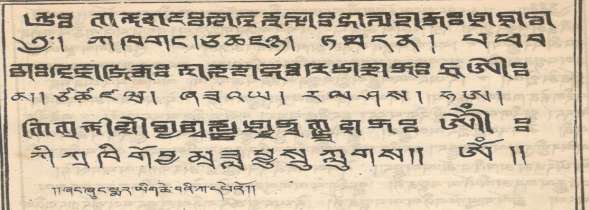Tibet (Myth, Religion and History)
by Tsewang Gyalpo Arya | 2019 | 70,035 words
This essay studies the history, religion and mythology of Tibet, and explores ancient traditions and culture dating back to more than 1000 BC. This research study is based on authoritative texts and commentaries of both Bon (Tibet's indigenous religion) and Buddhist masters available in a variety of sources. It further contains a comparative study ...
5. Zhangzhung Script
Although, origin of Tibetan scripts and writings are said to be based on Indian script, many facts and in the light of new evidence, it could be argued that this proposition could be reviewed. Scholars have now begun to look at Zhangzhung as the original source of Tibetan writing system.
Bon manuscripts and scholars assert that there was a Tibetan writing system much before Thonmi Sambhota in the 7th century, and it was based on sMar yig of Zhangzhung. According to Shar rdza bkra shis rgyal mtsan Tibetan scripts dBu chen and dDu med came from sMar chen and sMar chung script of Zhangzhung. Bonpo scriptures manitani that the Tibetan writing system came from the forty magical Thoyig [Tib: 'phrul gyi tho yig bzhi cu] letters of Zhangzhung, which has thirty consonant, six vowels and four punctuations. More detail on this subject could be found in the chapter "Tibetan Language and Writing System".
Let me reproduce the portion I have written on the similarity of Zhangzhung and Tibetan script.
Now let us look at the physical appearance of Zhangzhung and Tibetan script and observe the similarity. The script is from Zhu Yogi Nyima Dakpa's text.

From the above Zhangzhung and Tibetan scripts, we can clearly see the similarity and these Zhangzhung scripts exist in the form of texts even today. We have Zhangzhung -Tibetan language dictionary[1] and the script is still being used in Tibetan Bonpo monasteries.
Tshering thar, an Amdo scholar, has discovered and studied several ancient texts in some old monasteries in Tibet. He has in his article, "Bod yig gi 'byung gzhir gsar du dpyad pa" [A New Analysis of the Original Foundation of the Tibetan Script][2], concluded that origin of Tibetan written language is Zhangzhung sMar chung. Below is the sample of Zhangzhung sMar chung and Tibetan dbu med scripts that he has reproduced.

Shar rdza Ta shi rGyal mtsan, a noted scholar [1858-1933] in his work, "Legs bshad mzod" he wrote: "From the pristine letters of god emerged the sPung yig script of sTag gzig, it evolved to Yig rgan script of Zhangzhung, and then to sMar sbrag script, this evolved to two scripts of sMar chen and sMar chung. dBu can came from sMar chen and 'Bru ma from sMar chung. Varied forms of scripts came from 'Bru ma.[3] This was how the Tibetan scripts dBu chen and dBu med evolved.
Footnotes and references:
[1]:
1) Zhu rnal 'byor nyi ma drags pa, sGra yi don deb snan sel sgron me, India, 1965. 2) Erik Haarh's Zhangzhung Lauage, a grammar and dictionary of the unexplored language of the Tibetan bonpos. 3) Dan Matin's Zhangzhung Tibetan Dictionary
[2]:
Namkhai Norbu, The Light of Kailash Vol-I, p-162
[3]:
Shar za bKra shi Gyal mtsan, p-159. "dag pa lha'i yi ge stag gzig spungs yig tu bsgyur, de Zhangzhung gi yig rgan du bsgyur, de smar-sbrag tu bsgyur, de smar che chung du bsgyur, smar chen dbu chen nam gzab tu bsgyur, smar chung 'bru mar bsgyur, yig sna 'bru ma las brtsam."
